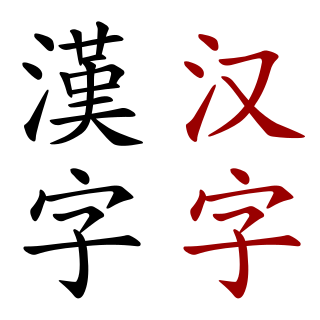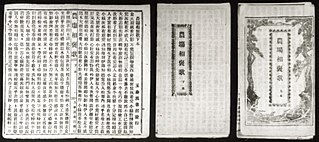Hiragana is a Japanese syllabary, part of the Japanese writing system, along with katakana as well as kanji.
Katakana is a Japanese syllabary, one component of the Japanese writing system along with hiragana, kanji and in some cases the Latin script. The word katakana means "fragmentary kana", as the katakana characters are derived from components or fragments of more complex kanji. Katakana and hiragana are both kana systems. With one or two minor exceptions, each syllable in the Japanese language is represented by one character or kana in each system. Each kana represents either a vowel such as "a" ; a consonant followed by a vowel such as "ka" ; or "n", a nasal sonorant which, depending on the context, sounds either like English m, n or ng or like the nasal vowels of Portuguese or Galician.
The term kana may refer to a number of syllabaries used to write Japanese phonological units, morae. Such syllabaries include: (1) the original kana, or magana, which were Chinese characters (kanji) used phonetically to transcribe Japanese; the most prominent magana system being man'yōgana (万葉仮名); the two descendants of man'yōgana, (2) cursive hiragana, and (3) angular katakana. There are also hentaigana, which are historical variants of the now standard hiragana. In current usage, 'kana' can simply mean hiragana and katakana.
An orthography is a set of conventions for writing a language, including norms of spelling, hyphenation, capitalization, word breaks, emphasis, and punctuation.
In the linguistic study of written languages, a syllabary is a set of written symbols that represent the syllables or moras which make up words.

Hepburn romanization is the most widely-used system of romanization for the Japanese language. Originally published in 1867 by American missionary James Curtis Hepburn as the standard in the first edition of his Japanese–English dictionary, the system is distinct from other romanization methods in its use of English orthography to phonetically transcribe sounds: for example, the syllable [ɕi] (し) is written as shi and [tɕa] (ちゃ) is written as cha, reflecting their spellings in English.

The word kanji comes from the Japanese word for logographic characters of the Chinese script, which were made a major part of the Japanese writing system along with the syllabic scripts of hiragana and katakana. More specifically, it refers to that set of Chinese characters directly incorporated into the written Japanese language with often Japanese pronunciation, inclusive of those few characters invented in Japan based on character components derived from other Chinese characters.

In a written language, a logogram or logograph is a written character that represents a word or morpheme. Chinese characters are generally logograms, as are many hieroglyphic and cuneiform characters. The use of logograms in writing is called logography, and a writing system that is based on logograms is called a logography or logographic system. All known logographies have some phonetic component, generally based on the rebus principle.

Written Chinese comprises Chinese characters used to represent the Chinese language. Chinese characters do not constitute an alphabet or a compact syllabary. Rather, the writing system is roughly logosyllabic; that is, a character generally represents one syllable of spoken Chinese and may be a word on its own or a part of a polysyllabic word. The characters themselves are often composed of parts that may represent physical objects, abstract notions, or pronunciation. Literacy requires the memorization of a great number of characters: college-educated Chinese speakers know about 4,000. The large number of Chinese characters has in part led to the adoption of Western alphabets or other complementary systems as auxiliary means of representing Chinese.

Chinese characters, also called hanzi, are logograms developed for the writing of Chinese. In addition, they have been adapted to write other East Asian languages, and remain a key component of the Japanese writing system where they are known as kanji. Chinese characters in South Korea, which are known as hanja, retain significant use in Korean academia to study its documents, history, literature and records. Chinese characters are the oldest continuously used system of writing in the world. By virtue of their widespread current use throughout East and Southeast Asia, as well as their profound historic use throughout the Sinosphere, Chinese characters are among the most widely adopted writing systems in the world by number of users.
A spelling reform is a deliberate, often authoritatively sanctioned or mandated change to spelling rules. Proposals for such reform are fairly common, and over the years, many languages have undergone such reforms. Recent high-profile examples are the German orthography reform of 1996 and the on-off Portuguese spelling reform of 1990, which is still being ratified.
Kunrei-shiki romanization is the Cabinet-ordered romanization system for transcribing the Japanese language into the Latin alphabet. Its name is rendered Kunreisiki rômazi in the system itself. Kunrei-shiki is sometimes known as the Monbushō system in English because it is taught in the Monbushō-approved elementary school curriculum. The ISO has standardized Kunrei-shiki, under ISO 3602.
The historical kana orthography, or old orthography, refers to the kana orthography in general use until orthographic reforms after World War II; the current orthography was adopted by Cabinet order in 1946. By that point the historical orthography was no longer in accord with Japanese pronunciation. It differs from modern usage in the number of characters and the way those characters are used. There was considerable opposition to the official adoption of the current orthography, on the grounds that the historical orthography conveys meanings better, and some writers continued to use it for many years after.
In the Japanese writing system, hentaigana are variant forms of hiragana.

The modern Japanese writing system uses a combination of logographic kanji, which are adopted Chinese characters, and syllabic kana. Kana itself consists of a pair of syllabaries: hiragana, used primarily for native or naturalised Japanese words and grammatical elements; and katakana, used primarily for foreign words and names, loanwords, onomatopoeia, scientific names, and sometimes for emphasis. Almost all written Japanese sentences contain a mixture of kanji and kana. Because of this mixture of scripts, in addition to a large inventory of kanji characters, the Japanese writing system is considered to be one of the most complicated in current use.

In sociolinguistics, digraphia refers to the use of more than one writing system for the same language. Synchronic digraphia is the coexistence of two or more writing systems for the same language, while diachronic digraphia is the replacement of one writing system by another for a particular language.

The Japanese script reform is the attempt to correlate standard spoken Japanese with the written word, which began during the Meiji period. This issue is known in Japan as the kokugo kokuji mondai. The reforms led to the development of the modern Japanese written language, and explain the arguments for official policies used to determine the usage and teaching of kanji rarely used in Japan.

The Chinese family of scripts are writing systems descended from the Chinese Oracle Bone Script and used for a variety of languages in East Asia. They include logosyllabic systems such as the Chinese script itself, and adaptations to other languages, such as Kanji (Japanese), Hanja (Korean), Chữ Hán and Chữ Nôm (Vietnamese) and Sawndip (Zhuang). More divergent are Tangut, Khitan large script, and its offspring Jurchen, as well as the Yi script, which were inspired by Chinese although not directly descended from it. The partially deciphered Khitan small script may be another. In addition, various phonetic scripts descend from Chinese characters, of which the best known are the various kana syllabaries, the zhuyin semi-syllabary, nüshu, and some influence on hangul.
The romanization of Japanese is the use of Latin script to write the Japanese language. This method of writing is sometimes referred to in Japanese as rōmaji.

Hokkien, a Min Nan variety of Chinese spoken in Southeastern China, Taiwan and Southeast Asia, does not have a unitary standardized writing system, in comparison with the well-developed written forms of Cantonese and Vernacular Chinese (Mandarin). In Taiwan, a standard for Written Hokkien has been developed by the Republic of China Ministry of Education including its Dictionary of Frequently-Used Taiwan Minnan, but there are a wide variety of different methods of writing in Vernacular Hokkien. Nevertheless, vernacular works written in the Hokkien are still commonly seen in literature, film, performing arts and music.







